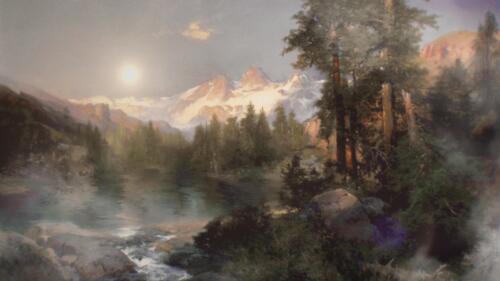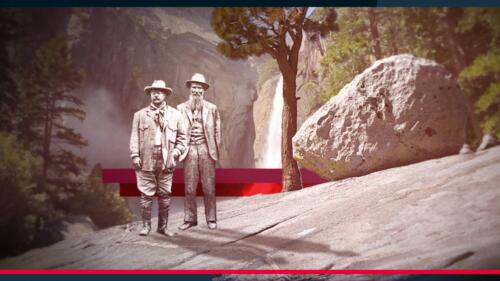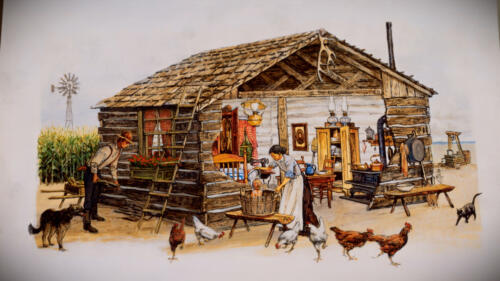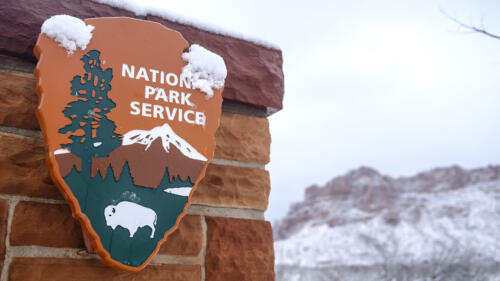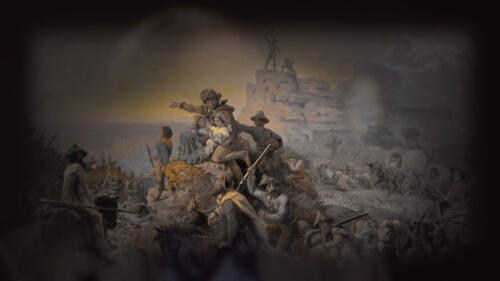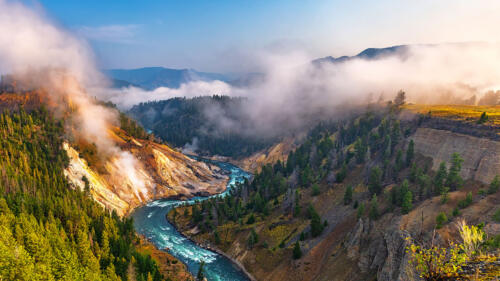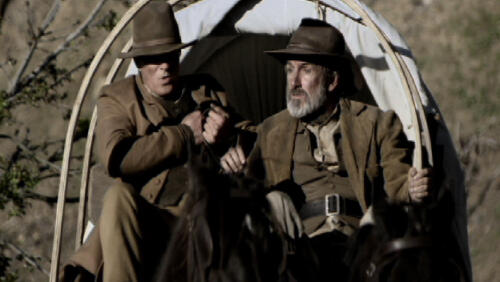The American West
The American West has always held a powerful place in the nation’s imagination—a sweeping, untamed landscape shaped by ambition, struggle and the promise of opportunity. From the diverse Indigenous nations who first called it home to the settlers, outlaws and industrialists who transformed its terrain, the West exists as both a real place and a powerful myth. Its history is a tapestry of resilience and injustice, bold innovation and profound upheaval.

Start Here

In 1804, Lewis and Clark set off on a journey filled with harrowing confrontations, harsh weather and fateful decisions.

They've had to fight continually to maintain their way of life.

The country, from its commerce to the environment to even its concept of time, was profoundly altered after the completion of the railroad's 1,776 miles of track.

Yellowstone's stunning natural beauty inspired the 19th-century push to set aside the land, where Indigenous people had been present for millennia.
Migrants Travel West on the Oregon Trail
Migrants Travel West on the Oregon Trail
Over 400,000 people travel West to start a new life and claim new land along the Oregon Trail, including Lucinda Brown. One-hundred seventy years later, one of her descendants sees a kettle from her journey for the first time.
Explore related articles

New studies combined archaeological data with oral history to figure out why everyone left.

Laura Ingalls Wilder had a secret collaborator with Libertarian Party connections.

Think of it as a mountain man convention.


It was the West's bloodiest clash over control of the open range.

Missionaries laid the foundation for communities and governance in the American frontier.

Pop culture portrayals obscure a much more complex story.

After Lewis and Clark's famed journey, these other explorers set out to document what lay beyond the frontier.

A better life awaited—people hoped—as miners, ranchers and more.

The 1803 land deal may have been one of history’s greatest bargains, but doubling America’s territory drew sharp criticism—over cost, governability and more.

Spanish settlers, independent Mexicans and southern frontiersmen jostled for control of Texas until the territory became the 28th U.S. state in 1845.

Oklahoma became the 46th state in 1907, following several acts that incorporated more Indian tribal land into U.S. territory.

Wyoming became the 44th state to join the union in 1890. The first U.S. territory to allow women to vote, Wyoming has the smallest population of all the states.

The construction of the interstate highway system in the mid-1950s forever changed the road once known as "America's Main Street."

Colorado attracted the ancient Pueblo peoples and the Plains Native Americans with its natural resoruces before becoming the 38th state of the union in 1876.

Chief John Ross devoted much of his life to fighting against the forced removal of his people from their ancestral lands.

Facing economic threats and violence, early Chinese immigrants banded together and created communities to survive—and thrive.

An economic relief program aimed specifically at helping Native American communities during the Great Depression, the legislation marked a sharp U-turn in federal policy toward Indigenous peoples.

Yellowstone's stunning natural beauty inspired the 19th-century push to set aside the land, where Indigenous people had been present for millennia.

As Honolulu and San Francisco faced outbreaks, the cities’ responses caused devastation to Asian communities.

White settlers feared the Lakota's Ghost Dance presaged an armed uprising. But US troops carried out the bloodbath.

Lincoln signed laws that gave away millions of acres of tribal land. And he approved the mass execution of 38 Dakota Sioux warriors.

As the Donner Party fought to survive in the snowy Sierra Nevada mountains, four brave rescue missions ensured some traumatized members made it out alive.

Though far from the main fighting, California made an outsized contribution to the Union victory, mostly in the form of gold and troops.

The Pueblo Revolt of 1680 drove out the Spanish for 12 years—and saved many Indigenous cultures from being wiped out.

Lozen fought against Mexican and American forces for 30 years, earning the nickname 'Apache Joan of Arc.'

As Europeans sought to control newly settled American land, wars raged between Native Americans and the frontiersmen who encroached on their territory, resources and trade.

Chinese immigrant workers and Indigenous tribes paid a particularly high price.

Classic Westerns have cemented the image of cowboys as white Americans, but the first wave of horse-riding cow wranglers in North America were Indigenous Mesoamerican men.

The fishing village in marshlands of present-day Louisiana was settled by the so-called Manilamen as early as 1763.

In the 1880s, mobs in Tacoma and Seattle forcibly expelled Chinese residents. In Tacoma, town officials organized the action months in advance.

In May 1887, around 30 Chinese laborers were mining gold in an isolated part of northeast Oregon, when the entire group was gunned down by a white gang of horse thieves. Initially referred to as the “Hells Canyon Massacre” or “Snake River Massacre” and the “Chinese Massacre at Deep Creek,” the event is considered one of the deadliest attacks against Chinese-Americans in U.S. history.

The Rock Springs Massacre began as a labor dispute in the territory of Wyoming between white and Chinese coal miners. The dispute led to violence by white mobs on September 2, 1885 that left 28 Chinese miners dead and 15 others wounded.

The Angel Island Immigration Station served as the main immigration facility on the West Coast of the United States from 1910 to 1940. Many immigrants from China or other Asian countries were detained there for extended periods thanks to the Chinese Exclusion Act (1882) and other discriminatory immigration laws.

The 1875 Page Act was one of the earliest pieces of federal legislation to restrict immigration to the United States.

Jesse James. Billy the Kid. Butch and Sundance. Their iconic status endures, despite their history of violent crime.

While Mount Rushmore is considered a treasured destination for some Americans, to Native Americans, it can represent a stinging legacy.

From 1778 to 1871, the United States signed some 368 treaties with various Indigenous people across the North American continent.

Horses were first introduced to Native American tribes via European explorers. For the buffalo-hunting Plains Indians, the swift, strong animals quickly became prized.

It's clear the California rangers beheaded someone in 1853. What isn't clear is whether it was the infamous bandit known as 'Joaquín.'

The swift, often comfortable ride on the Transcontinental Railroad opened up the American West to new settlement.

Following the Bear Flag Revolt of 1846, California existed as an independent nation—for 25 days.

After fighting in the Civil War and later military engagements, the famous all-black regiments protected the National Parks.

In 1804, Lewis and Clark set off on a journey filled with harrowing confrontations, harsh weather and fateful decisions.

The explorers not only produced maps from their 1804-1806 expedition to the American West, they also recorded some 122 animals new to science.

The legendary medicine man and guerrilla warrior was so expert at eluding the enemy, he was considered to be protected by supernatural powers.

Severe exposure, starvation and disease ravaged tribes during their forced migration to present-day Oklahoma.

The country, from its commerce to the environment to even its concept of time, was profoundly altered after the completion of the railroad's 1,776 miles of track.

The executive order acknowledged state-sponsored violence and discrimination against Native peoples as part of 'California's dark history.'

At first railroad companies were reluctant to hire Chinese workers, but the immigrants soon proved to be vital.

The pioneers hoped to shave 300 miles off their journey. But the route they took to California had never been tested.

The Chinese Exclusion Act of 1882 was one of several discriminatory U.S. laws that curbed Chinese immigration and made Chinese people ineligible for naturalization.

Napoleon was eager to sell—but the purchase would end up expanding slavery in the U.S.

In the Mexican-American War, Mexico faced an enemy that was coming into its own as a military power.

Spies and scouts, mothers and homestead keepers, women quietly made their mark on America's changing western frontier.

Land symbolized opportunity to generations of Americans, starting with colonists.

By the close of the Indian Wars in the late 19th century, fewer than 238,000 Indigenous people remained of the estimated 5 million-plus living in North America before European contact.

The Battle of the Little Bighorn—also known as Custer’s Last Stand—was the most ferocious battle of the Sioux Wars. Colonel George Custer and his men never stood a fighting chance.

Where Is the Northwest Passage? The Northwest Passage spans roughly 900 miles from the North Atlantic north of Canada’s Baffin Island in the east to the Beaufort Sea north of the U.S. state of Alaska in the west. It’s located entirely within the Arctic ...

The Klondike Gold Rush was a mass influx of prospecting migrants to the Canadian Yukon Territory and Alaska after gold was discovered in those regions in 1896.

The Santa Fe Trail, a 900-mile route connecting Franklin, Missouri, to Santa Fe, New Mexico, played a crucial role in America's westward expansion in the 1800s.

Indian reservations were created by the 1851 Indian Appropriations Act as a means for minimizing conflict and encouraging cultural change among Native tribes.

Buffalo Soldiers were the Black U.S. servicemen who fought on the Western frontier after the Civil War and were named by the Native Americans they encountered.

The Oregon Trail, a 2,000-mile route from Independence, Missouri, to Oregon City, Oregon, was used by hundreds of thousands of pioneers in the mid-1800s to emigrate west.

Up to 16,000 Native Americans were murdered in cold blood after California became a state.

Would-be mail thieves didn’t stand a chance against Stagecoach Mary. The hard-drinking, quick-shooting mail carrier sported two guns and men’s clothing.

Chinese Immigration to the United States Most of the early Chinese immigration to the United States can be traced to the mid-1800s. These early immigrants—some 25,000 in the 1850s alone—came seeking economic opportunity in America. The Chinese arriving ...

Check out seven facts about this infamous chapter in American history.

Explore 10 surprising facts about the man often called the “King of the Wild Frontier.”

Find out more about the lives of six adventurers who made their mark on the American frontier.

Check out nine surprising facts about the route that once served as the gateway to the American West.

Explore 10 surprising facts about one of America’s first and greatest expeditions of discovery.

10 surprising facts about the UNESCO World Heritage Site.

The Black infantry regiments fought in the American-Indian Wars, captured cattle thieves and even served as park rangers.

Find out more about this Old West icon, from how he met his friend Doc Holliday to what happened to him after the Tombstone gunfight.

Today we may know them simply as Texans, but deciding what to call the people living in Texas in the pre-Texas Revolution era was a matter of some confusion. According to an issue of the Telegraph and Texas Register published on November 7, 1835, various people used the terms Texans, Texonians, Texasians and Texicans, but: […]

Now an elite police squad tasked with the state’s most serious criminal investigations, the Texas Rangers have undergone many changes in their colorful history—and some particularly memorable characters have emerged over the years.

A dispute over a small cannon in 1835 sparked the Texas Revolution and immortalized the battle cry “Come and Take It.”

Explore 10 true stories of the Wild West, some of them stranger than fiction.

Cowboys originated with the Spanish settlers in modern Mexico, before becoming synonymous with the American West during the cattle drives of the 1800s.

Spindletop was an enormous geyser of oil that exploded from a drilling site at Spindletop Hill, a mound located in southeastern Texas, in 1901. Reaching a height of more than 150 feet and producing close to 100,000 barrels a day, the “gusher” was more powerful than any previously seen in the world. A booming oil industry soon grew up around the oil field.

In 1862, the Central Pacific and the Union Pacific Railroad Companies began building a transcontinental railroad that would link the United States from east to west. Over the next seven years, the two companies raced toward each other from Sacramento, California on the one side to Omaha, Nebraska on the other, struggling against great risks before they met at Promontory, Utah, on May 10, 1869.

The Hoover Dam was devised as a means for controlling the wild waters of the Colorado River and became the world's largest dam upon its completion in 1935.

The Wilderness Road, blazed by frontiersman Daniel Boone through the Cumberland Gap, opened a western pathway that led to the first settlements in Kentucky.

Manifest Destiny expressed the philosophy that drove 19th-century U.S. territorial expansion. It contended that the United States was destined by God to expand its dominion and spread democracy and capitalism across the entire North American continent.

Early History of the Alamo Spanish settlers built the Mission San Antonio de Valero, named for St. Anthony of Padua, on the banks of the San Antonio River around 1718. They also established the nearby military garrison of San Antonio de Béxar, which soo...

Westward expansion began with the Louisiana Purchase and was fueled by the Gold Rush, the Oregon Trail and a belief in "manifest destiny."

The Louisiana Purchase of 1803 introduced about 828,000,000 square miles of territory from France into the United States, thereby doubling the size of the young republic. Explore the facts about this important acquisition and its lasting legacy on Thomas Jefferson’s presidency.

Where Is the Grand Canyon? The Grand Canyon is located in northern Arizona, northwest of the city of Flagstaff. The canyon measures over 270 miles long, up to 18 miles wide and a mile deep, making it one of the biggest canyons in the world. This natural...

The Trail of Tears was the deadly journey Native Americans were forced to undergo after being removed from their ancestral lands.

Sitting Bull (1831-1890) was the Native American chief under whom the Lakota tribes united in their struggle for survival on the North American Great Plains.

Battle of San Jacinto: Background After gaining independence from Spain in the 1820s, Mexico welcomed foreign settlers to sparsely populated Texas, and a large group of Americans led by Stephen F. Austin (1793-1836) settled along the Brazos River. The A...

Sam Houston (1793-1863) was a lawyer, congressman and senator from Tennessee. After moving to Texas in 1832, he joined the conflict between U.S. settlers and the Mexican government and became commander of the local army. On April 21, 1836, Houston and his men defeated Mexican General Antonio López de Santa Anna at San Jacinto to secure Texan independence.

The state is one of the nation's top producers of wine, hazelnuts and Christmas trees.

The Mexican-American War was a 1846-1848 conflict over vast territories in the American West, which the Treaty of Guadalupe Hidalgo gave to the United States.

The Lewis and Clark Expedition began in 1804 when Thomas Jefferson asked Meriwether Lewis and William Clark to explore the lands of the Louisiana Purchase.

The Treaty of Guadalupe Hidalgo in 1848 ended the Mexican-American War, with much of the current U.S. Southwest ceded to the United States from Mexico.

George Armstrong Custer rose to fame as a young Union commander in the Civil War before his death at the Battle of the Little Bighorn in 1876.

The Battle of Timbers, on August 20, 1794, was the last major conflict of the Northwest Territory Indian War between Native Americans and the United States.

California became the 31st state in 1850. It leads the U.S. in agricultural production, it is known for its tech industry, and it is home to famous cultural institutions and national parks, including Hollywood, Disneyland, Yosemite National Park, Alcatraz, Angel Island and the Golden Gate Bridge.

Arizona’s Native American History Indigenous hunter-gatherers arrived in the area now known as Arizona more than 12,000 years ago. Today, the state has 22 federally-recognized Native American tribes, including the Navajo Nation, Hopi Tribe, Tohono O’odh...

Wyatt Earp, a famous figure from the American West, is best remembered for his participation in a deadly gunfight at the OK Corral in Tombstone, Arizona.

Apache chief Geronimo (1829-1909) led his followers on a series of escapes in the mid-1870s that bolstered his legend and embarrassed the U.S. government. He surrendered to General Nelson Miles in 1886, and remained a celebrity in captivity until his death at Oklahoma’s Fort Sill.
